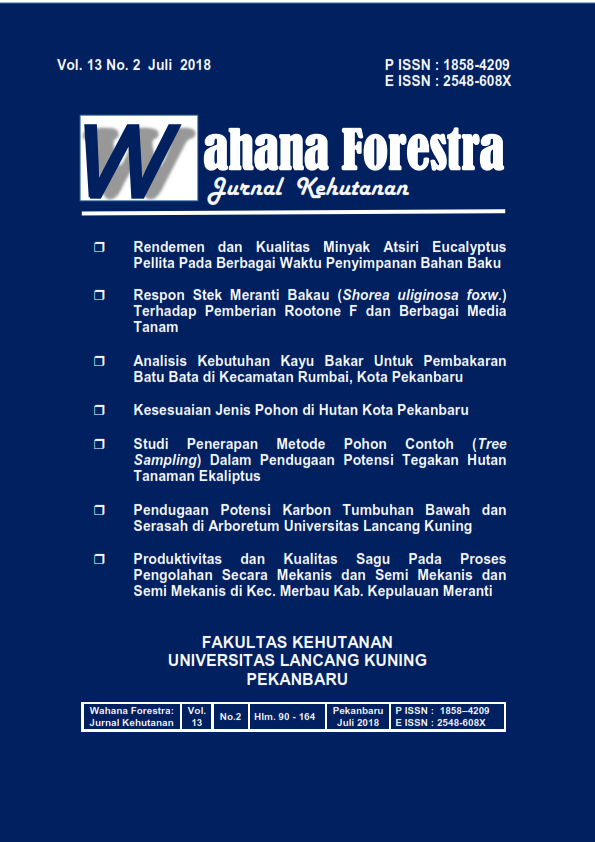KESESUAIAN JENIS POHON DI HUTAN KOTA PEKANBARU
DOI:
https://doi.org/10.31849/forestra.v13i2.1566Keywords:
urban forest, tree species, conformityAbstract
City forest with many stratum provides the surrounding environment is relatively more comfortable than the low stratum. In order to achieve success in achieving management objectives, the types planted in urban forest development and development programs should be selected based on the consideration that crops grow well and can cope with emerging environmental problems in the region. Identifying the suitability of existing tree species in urban forest is intended to obtain maximum plant growth and municipal forest benefits. The purpose of this study is to identify the suitability of forest conifer tree species in Pekanbaru City. Data collection is done by survey in the field by defecting the existing tree species in urban forest. The result of tree species identification is used to evaluate the suitability of tree species of forest forest. A literature study was conducted to find out the growing requirements and characteristics of tree species of urban forest in the study sites. Data analysis is conducted by considering silvicultural, management and aesthetic requirements. Based on this criteria are made that is appropriate, quite appropriate, and not appropriate. Based on the results of the study can be summarized as follows: The type of urban forest in Pekanbaru City is the protection and recreation with the form of clusters / gangs and paths; There are 15 species of trees that have appropriate criteria based on silvicultural, management and aesthetic requirements; There are 15 species of trees capable of controlling air pollution.
References
Christopoulou O , Serafeim P, Dionissios M. 2007. "Peri‐urban and urban forests in Greece: obstacle or advantage to urban development?", Management of Environmental Quality: An International Journal, Vol. 18 Issue: 4, pp.382-395, https: //doi.org/10.1108/14777830710753794.
Dare AM, Idris AA, Adebayo MS. 2015. "Urban trees forest management in Abeokuta Metropolis, Ogun State, Nigeria: An application of contingent valuation method", Management of Environmental Quality: An International Journal, Vol. 26 Issue: 1, pp.72-83, https://doi.org/10.1108/MEQ-06-2014-0094.
Hamzah, Rike PT, Nursanti. 2016. Peningkatan Populasi dan Keragaman Jenis Hutan Kota Dengan Peran Serta Masyarakat di Kota Jambi. Jurnal Pengabdian pada Masyarakat 31: 44-51.
Irwan SNR, Kaharudin. 2010. Studi Kenyamanan untuk Aktivitas di Lanskap Hutan Kota UGM (Studi Kasus : Kluster Argo UGM). Jurnal Ilmu Kehutanan IV : 98-110.
Karanikola P, Thomas P, Stilianos T, Aikaterini KK. 2016. "A perceptual study of users’ expectations of urban green infrastructure in Kalamaria, municipality of Greece", Management of Environmental Quality: An International Journal, Vol. 27 Issue: 5, pp.568-584, https://doi.org/10.1108/MEQ-12-2014-0176.
Mukhlison. 2013. Pemilihan Jenis Pohon untuk Pengembangan Hutan Kota di Kawasan Perkotaan Yogyakarta. Jurnal Ilmu Kehutanan VII : 37-47.
Noviady I, Reza RR. 2015. Identifikasi kondisi kesehatan pohon peneduh di kawasan Ecopark, Cibinong Science Center-Botanic Gardens. Pros Sem Nas Masy Biodiv Indon 1 : 1385-1391.
Samsoedin I, Endro S. 2006. Pembangunan dan Pengelolaan Hutan Kota. Ekspose Hasil-hasil Penelitian : Konservasi dan Rehabilitasi Sumberdaya Hutan. Padang.
Sundari ES. 2005. Studi untuk Menentukan Fungsi Hutan Kota dalam Masalah Lingkungan Perkotaan. Jurnal PWK UNISBA : 68-83.






